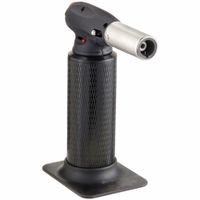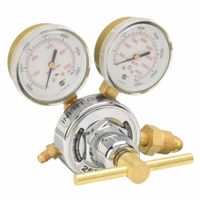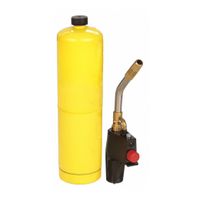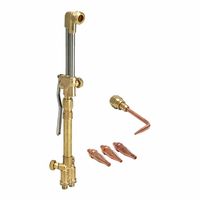Call +(254) 703 030 000 / 751 483 999 / 721 704 777
.....Read More
Frequently Asked Questions
What is oxy-fuel welding and cutting?
Oxy-fuel welding and cutting is a process that uses a combination of oxygen and a fuel gas to weld and cut metals. The most common fuel gas used is acetylene, but other gases like propane, hydrogen, and natural gas can also be used. The process involves mixing the fuel gas with oxygen in a torch to produce a flame that can reach temperatures of around 3,200°C (5,792°F), which is sufficient to melt most metals.
In oxy-fuel welding, the flame is used to heat the metal pieces to be joined until they reach a molten state. A filler rod may be added to the molten pool to help form a strong joint. The process is versatile and can be used on a variety of metals, including steel, aluminum, and copper alloys. It is particularly useful for welding thin materials and for applications where precise control over the heat input is required.
Oxy-fuel cutting, on the other hand, involves using the flame to heat the metal to its ignition temperature and then introducing a stream of pure oxygen to oxidize and blow away the molten metal, effectively cutting through the material. This method is widely used for cutting steel and other ferrous metals, as it is efficient and can be used for both straight and bevel cuts.
The equipment for oxy-fuel welding and cutting typically includes a torch, hoses, regulators, and cylinders for the oxygen and fuel gas. Safety is a critical consideration, as the process involves handling flammable gases and high temperatures. Proper protective gear, such as goggles and gloves, is essential to protect against burns and eye damage.
How do you safely operate oxy-fuel equipment?
To safely operate oxy-fuel equipment, follow these guidelines:
1. **Training and Knowledge**: Ensure all operators are trained in the use of oxy-fuel equipment and understand the risks involved.
2. **Personal Protective Equipment (PPE)**: Wear appropriate PPE, including safety goggles, flame-resistant clothing, gloves, and steel-toed boots.
3. **Equipment Inspection**: Before use, inspect hoses, regulators, and torches for leaks, damage, or wear. Replace any faulty components.
4. **Proper Setup**: Secure cylinders in an upright position. Use a cylinder cart for transport. Ensure the work area is well-ventilated.
5. **Check Connections**: Ensure all connections are tight and leak-free. Use soapy water to check for leaks at connections.
6. **Pressure Settings**: Set the correct pressure for both oxygen and fuel gas according to the manufacturer's instructions.
7. **Lighting the Torch**: Open the fuel gas valve slightly and ignite with a spark lighter. Gradually open the oxygen valve to achieve the desired flame.
8. **Flame Adjustment**: Adjust the flame to a neutral flame for cutting or welding, avoiding an oxidizing or carburizing flame.
9. **Operational Safety**: Keep the torch pointed away from yourself and others. Be aware of your surroundings to prevent fire hazards.
10. **Shutting Down**: Close the oxygen valve first, then the fuel gas valve. This prevents flashbacks. Bleed the lines and release pressure from the regulators.
11. **Storage**: Store cylinders in a well-ventilated area, away from heat sources, and secure them to prevent falling.
12. **Emergency Preparedness**: Have fire extinguishers and first aid kits readily available. Know emergency procedures and evacuation routes.
By adhering to these safety practices, you can minimize risks and ensure safe operation of oxy-fuel equipment.
What are the differences between acetylene and propane in oxy-fuel applications?
Acetylene and propane are both used as fuel gases in oxy-fuel applications, but they have distinct differences that affect their performance and suitability for various tasks.
1. **Flame Temperature**: Acetylene produces a higher flame temperature, reaching approximately 3,160°C (5,720°F) when combined with oxygen. Propane, on the other hand, reaches about 2,828°C (5,120°F). The higher temperature of acetylene makes it more suitable for cutting and welding applications that require intense heat.
2. **Combustion Characteristics**: Acetylene has a faster combustion speed, which results in a more concentrated and precise flame. This makes it ideal for tasks requiring pinpoint accuracy, such as welding thin metals. Propane burns slower, producing a broader and less intense flame, which is better for preheating and cutting thicker materials.
3. **Cost and Availability**: Propane is generally more cost-effective and widely available than acetylene. It is often used for applications where high precision is not critical, and cost efficiency is a priority.
4. **Safety**: Acetylene is highly flammable and unstable at pressures above 15 psi, requiring careful handling and storage. Propane is more stable and safer to store and transport, making it a preferred choice in environments where safety is a concern.
5. **Fuel Efficiency**: Acetylene is more efficient in terms of the amount of heat produced per unit of fuel, which can be advantageous for specific applications. However, propane's lower cost can offset its lower efficiency in some cases.
6. **Applications**: Acetylene is preferred for welding, brazing, and cutting applications that demand high precision and heat. Propane is often used for heating, soldering, and cutting thicker materials where precision is less critical.
These differences influence the choice of fuel based on the specific requirements of the task, cost considerations, and safety protocols.
How do you set up an oxy-fuel torch?
1. **Safety First**: Wear protective gear, including goggles, gloves, and flame-resistant clothing. Ensure the work area is well-ventilated and free of flammable materials.
2. **Check Equipment**: Inspect hoses, regulators, and torch for damage. Ensure cylinders are secured upright.
3. **Connect Regulators**: Attach the oxygen regulator to the oxygen cylinder and the fuel regulator (acetylene or propane) to the fuel cylinder. Tighten with a wrench.
4. **Attach Hoses**: Connect the red hose to the fuel regulator and the green hose to the oxygen regulator. Ensure connections are tight.
5. **Connect Torch**: Attach the other ends of the hoses to the torch handle. The red hose connects to the fuel inlet, and the green hose connects to the oxygen inlet.
6. **Check for Leaks**: Open cylinder valves slightly and apply soapy water to connections. Look for bubbles indicating leaks. Tighten connections if needed.
7. **Set Pressure**: Open the oxygen cylinder valve fully. Adjust the oxygen regulator to the desired pressure (usually 20-40 psi). Open the fuel cylinder valve 1/4 turn. Adjust the fuel regulator to the desired pressure (usually 5-10 psi for acetylene).
8. **Purge Lines**: Open the torch valves one at a time to purge air from the lines, starting with the fuel valve, then the oxygen valve. Close them after purging.
9. **Lighting the Torch**: Open the fuel valve slightly and ignite with a spark lighter. Slowly open the oxygen valve and adjust to achieve a neutral flame.
10. **Adjust Flame**: Fine-tune the oxygen and fuel valves to achieve the desired flame type (neutral, oxidizing, or carburizing).
11. **Shutdown**: Close the fuel valve first, then the oxygen valve. Close cylinder valves and release pressure from the regulators.
What safety precautions should be taken when using gas cylinders?
When using gas cylinders, several safety precautions are essential to prevent accidents and ensure safe handling:
1. **Storage**: Store cylinders upright in a well-ventilated, dry area away from heat sources, flammable materials, and direct sunlight. Secure them with chains or straps to prevent tipping.
2. **Handling**: Use appropriate equipment like cylinder trolleys for transportation. Avoid rolling or dragging cylinders. Always keep the protective cap on when not in use.
3. **Identification**: Clearly label cylinders with their contents and ensure the labels are visible. Never use a cylinder if the label is missing or illegible.
4. **Inspection**: Regularly inspect cylinders for leaks, damage, or corrosion. Use soapy water to check for leaks at connections and valves.
5. **Ventilation**: Ensure adequate ventilation in areas where gas is used to prevent accumulation of gas, which can lead to asphyxiation or explosion.
6. **Connections**: Use the correct regulator and fittings for the specific gas type. Ensure all connections are tight and leak-free.
7. **Usage**: Open valves slowly and only when the cylinder is secured. Never use oil or grease on valves or fittings, as they can react with certain gases.
8. **Training**: Ensure all personnel handling gas cylinders are trained in their safe use, potential hazards, and emergency procedures.
9. **Emergency Preparedness**: Have fire extinguishers and first aid kits readily available. Know the emergency shutdown procedures and evacuation routes.
10. **Disposal**: Return empty or unused cylinders to the supplier. Do not attempt to refill or modify cylinders.
By adhering to these precautions, the risks associated with gas cylinder use can be significantly minimized, ensuring a safer working environment.
How do you maintain and store oxy-fuel equipment?
To maintain and store oxy-fuel equipment, follow these guidelines:
1. **Inspection**: Regularly inspect hoses, regulators, torches, and cylinders for wear, leaks, or damage. Replace any faulty components immediately.
2. **Cleaning**: Keep equipment clean and free from oil, grease, and dirt. Use a soft cloth to wipe down surfaces and ensure connections are free of debris.
3. **Leak Testing**: Perform leak tests on connections using a soapy water solution. Bubbles indicate leaks that need to be addressed.
4. **Regulator Maintenance**: Check regulators for proper function. Ensure gauges are accurate and diaphragms are intact. Do not attempt repairs; consult a professional if issues arise.
5. **Hose Care**: Store hoses coiled and off the ground to prevent kinks and damage. Avoid exposure to direct sunlight and chemicals.
6. **Torch Maintenance**: Clean torch tips regularly to prevent clogging. Use appropriate tip cleaners and avoid using metal objects that can damage the tip.
7. **Cylinder Storage**: Store cylinders upright and secure them to prevent tipping. Keep them in a well-ventilated area away from heat sources and flammable materials.
8. **Valve Protection**: Ensure cylinder valves are closed when not in use. Use protective caps on cylinders during storage and transport.
9. **Proper Labeling**: Clearly label cylinders and equipment to avoid confusion and ensure safe handling.
10. **Training**: Ensure all users are trained in the safe operation and maintenance of oxy-fuel equipment.
11. **Documentation**: Keep records of maintenance and inspections to track equipment condition and ensure compliance with safety standards.
By adhering to these practices, you can ensure the longevity and safe operation of oxy-fuel equipment.
What are the common uses of MAP-Pro and propane equipment?
MAP-Pro and propane are both commonly used fuels in various applications due to their portability and efficiency.
MAP-Pro, which stands for Methylacetylene-Propadiene Propane, is often used in tasks requiring higher temperatures than propane can provide. It is commonly employed in:
1. **Plumbing and HVAC**: MAP-Pro is used for soldering and brazing copper pipes, as it reaches higher temperatures quickly, making it ideal for joining metals.
2. **Metalworking**: It is used for tasks like cutting, welding, and heat treating metals due to its high flame temperature.
3. **Automotive Repairs**: MAP-Pro is used for loosening rusted bolts and nuts, as the intense heat can expand and break the rust bond.
4. **Jewelry Making**: The high temperature is suitable for melting and shaping metals in jewelry crafting.
Propane, on the other hand, is versatile and widely used in:
1. **Cooking and Grilling**: Propane is a popular fuel for outdoor grills, stoves, and portable cooking appliances due to its clean burn and ease of use.
2. **Heating**: It is used in portable heaters, space heaters, and residential heating systems, especially in areas without natural gas lines.
3. **Camping and Outdoor Activities**: Propane is used in lanterns, portable stoves, and heaters, providing a reliable energy source in remote locations.
4. **Industrial Applications**: It powers forklifts, generators, and other equipment in warehouses and construction sites.
5. **Agriculture**: Propane is used for crop drying, weed control, and heating livestock facilities.
Both MAP-Pro and propane are valued for their portability and efficiency, but their specific applications depend on the temperature requirements and the nature of the task.
How do you choose the right gas regulator and flowmeter?
To choose the right gas regulator and flowmeter, consider the following factors:
1. **Gas Type**: Identify the specific gas you are using, as different gases require different materials and designs to ensure compatibility and safety.
2. **Pressure Requirements**: Determine the inlet and outlet pressure requirements. The regulator must handle the maximum inlet pressure and provide the desired outlet pressure range.
3. **Flow Rate**: Assess the required flow rate for your application. The flowmeter should accurately measure and control the flow within this range.
4. **Material Compatibility**: Ensure the materials of the regulator and flowmeter are compatible with the gas to prevent corrosion or reactions.
5. **Connection Size and Type**: Check the connection sizes and types to ensure they fit with your existing equipment. Common types include NPT, BSP, and compression fittings.
6. **Environment**: Consider the operating environment, including temperature, humidity, and potential exposure to corrosive substances, which may affect the choice of materials and design.
7. **Regulator Type**: Choose between single-stage or dual-stage regulators. Single-stage regulators are suitable for applications with stable inlet pressures, while dual-stage regulators provide more consistent outlet pressure in varying conditions.
8. **Flowmeter Type**: Decide between variable area (rotameter), mass flow, or thermal flowmeters based on accuracy, cost, and application needs.
9. **Safety Features**: Look for features like pressure relief valves and gauges for monitoring and safety.
10. **Compliance and Standards**: Ensure the equipment meets relevant industry standards and certifications for safety and performance.
11. **Budget**: Balance cost with quality and features to find a solution that meets your needs without overspending.
By considering these factors, you can select a gas regulator and flowmeter that ensure safety, efficiency, and reliability for your specific application.
What are the advantages of using air-acetylene equipment?
Air-acetylene equipment offers several advantages, particularly in applications like soldering, brazing, and light welding. Firstly, it is highly portable and easy to use, making it ideal for fieldwork and situations where mobility is crucial. The equipment is generally lightweight and compact, allowing for easy transportation and setup.
Secondly, air-acetylene systems are cost-effective. They do not require an oxygen cylinder, as they use atmospheric air, reducing both the initial investment and ongoing operational costs. This simplicity also translates to lower maintenance requirements, as there are fewer components that can malfunction or require servicing.
The flame produced by air-acetylene equipment is consistent and reliable, providing a stable heat source that is sufficient for many applications. The flame temperature, while lower than that of oxy-acetylene systems, is adequate for tasks like soldering and brazing, ensuring effective and efficient work without the risk of overheating or damaging materials.
Safety is another significant advantage. The absence of an oxygen cylinder reduces the risk of explosive hazards, making air-acetylene systems safer to operate, especially in confined spaces or less controlled environments. This safety aspect is particularly appealing for users who may not have extensive training in handling more complex gas systems.
Finally, air-acetylene equipment is versatile. It can be used on a variety of materials, including copper, brass, and some steels, making it suitable for a wide range of applications in plumbing, HVAC, and general maintenance work. This versatility, combined with its other benefits, makes air-acetylene equipment a popular choice for professionals and hobbyists alike.
How do you refill and maintain butane torches and lighters?
To refill and maintain butane torches and lighters, follow these steps:
1. **Refilling:**
- **Preparation:** Ensure the lighter or torch is completely cool and empty. Work in a well-ventilated area away from open flames.
- **Select Butane:** Use high-quality butane to prevent clogging and ensure optimal performance.
- **Bleed the Tank:** Use a small screwdriver or a similar tool to press the refill valve to release any remaining gas and air.
- **Refill:** Hold the lighter or torch upside down. Insert the butane canister's nozzle into the refill valve. Press down firmly for about 5-10 seconds. Repeat if necessary, but avoid overfilling.
- **Rest:** Allow the lighter or torch to rest for a few minutes to let the butane stabilize.
2. **Maintenance:**
- **Cleaning:** Regularly clean the nozzle and burner area with a soft brush to remove debris and soot.
- **Adjust Flame:** Use the adjustment wheel or screw to set the flame to the desired height. Avoid setting it too high to prevent damage.
- **Check for Leaks:** After refilling, check for gas leaks by listening for hissing sounds or smelling gas. If detected, do not use the lighter or torch.
- **Storage:** Store in a cool, dry place away from direct sunlight and heat sources. Ensure the safety lock is engaged if available.
- **Regular Inspection:** Periodically inspect for wear and tear, especially the ignition system and seals. Replace parts if necessary.
By following these steps, you can ensure the longevity and safe operation of your butane torches and lighters.






